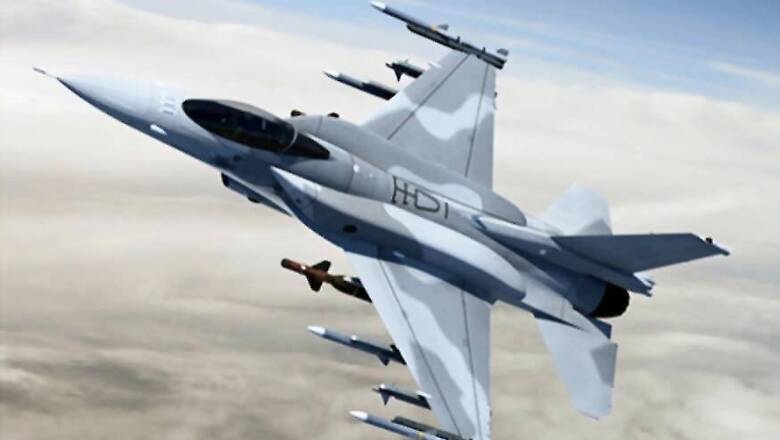
views
New Delhi: The Indian Air Force (IAF) is largely dependent on MiG 21s and MiG 27s, but the Soviet-era aircraft are fast becoming obsolete and reports of malfunction are not uncommon. So bad is the condition of the MiG that it has earned the ominous epithet “Flying Coffin” and “Widow-maker”. To replace the fleet, India is set to buy 126 aircraft and one of the contenders for the mammoth deal is US-based defence manufacturer Lockheed Martin. The firm is vying not only for the F-16 Block 70 contract, but is also looking to shift the entire production line to India.
News18 spoke to Lockheed Martin National Executive for India Abhay Paranjape and Integrated Fighter Group Director of Business Development Randall Howard on what the deal means for Prime Minister Narendra Modi’s Make in India plan and why the F-16 is best suited to meet India’s defence needs.
US Secretary of State Rex Tillerson was in India recently and said the country was a major defence partner. What does that entail and where does the Indo-US defence partnership go from here?
Abhay Paranjape: We can talk about it from our perspective because we are talking about shifting the entire F16 production line to India, where all future F16s sold around the world will be made in the Indian production line. That solidifies and strengthens the relationship between the two countries like never before.
There are fears that American firms may not be willing to part with proprietary technology. Where do you stand on the technology transfer issue?
Abhay Paranjape: Every company will have proprietary issues that will need to be addressed between two companies. We are confident that we will be able to resolve that. What we need to protect, we will protect. What Indian companies need to protect, they will also protect. Technology transfer is not just a one-way handover of technology.
Indian companies already have a lot of technology that they’ve developed. But how do we take it to the next level, to being a global player? That is where LM (Lockheed Martin) has excelled in the past. We have built F16s in the past in multiple countries. We will continue to bring in industries from around the world into India and will continue to expand industries from India into this global supply chain. And Indian industries will become an integral part of the global supply chain for F16s.
But without technology transfer, India will end up being a backend workshop for Lockheed Martin. What does India stand to gain technologically?
Abhay Paranjape: The Block 70 is the latest variant of the F16, which is what we are offering. Besides, the Block 70 won’t be the last. There will be future upgrades which will be technologically more advanced and the Indian industry will be right in the middle of defining what that future will look like. So Indian industry is not just going to make components for 100 Indian aircraft, it will be part of defining what the future of this aircraft will look like.
You have a joint venture with Tata. What do they bring to the table?
Abhay Paranjape: We have a joint venture with Tata Advanced Systems Limited. We have signed an agreement with them that we will manufacture this aircraft in India with TASL. What sort of a partnership it will be, those details are yet to be discussed. But what we have seen and experienced is that the LM-Tata team in Hyderabad can build large components of the C-130 and can build them on schedule, on target for price and on target for quality. There is a capability that exists in TASL. We now have the confidence that we can use that as a kernel to build an entire manufacturing ecosystem.
India is the largest arms importer in the world, with manufacturers around the world willing to sell to it. Why is the USA best suited to supply India’s defence needs?
Randall Howard: I think the relationship has been growing for a while. As the two largest democracies in the world, it portends great things for the future. We have great products. America builds and invests in defence products. So the opportunity is for our friends and allies to access those products.
The F16, in particular, the Block 70, is technology that is the result of billions of dollars of investments over time over multiple product lines. So we are taking the tech and putting them on the F16 that come out of the F35. And the tech in the F35 have been developed based on investment in the F22. The technology of the F22 has come from investment in the F117. So there is this circle of technology enhancements and we are taking that now and rolling it back to where it started — the F16.
The opportunity for India is to access this tech, not just for themselves, but also for the global demand.
India has been trying to replace its old fleet. Why is the F16 the best aircraft for that purpose?
Randall Howard: From an aerodynamic perspective, this aircraft accelerates more quickly. The instantaneous G-turn is the same, but the sustained G-turn is better. The aircraft carries more fuel. It goes much further. It carries 30-40% more ordnance.
If you go at 400-500 kmph, how long can an aircraft keep going and protect a particular airspace? You can go 40%, sometimes 50% longer, with an F16. This is one of the reasons so many (F16s) are flying all over the world. That is why customers are saying again and again — I want more F16s. We have had repeat buys 55 times. What we’ve done with the Block 70 is that we have taken the radar technology of the F35, the very latest and greatest radar tech in the US, and we are putting that in the F16.
One of Lockheed Martin’s biggest clients is the Pakistan Air Force. Given that India and Pakistan are regional rivals, how does that complicate matters with this deal?
Randall Howard: I think that’s a topic to discuss with the two governments. What I would say is that this is a unique opportunity going forward as we focus on the future to put the production of the F16 in India. We are focused on the future. There are many customers. There are 27 countries that fly the F16 and Pakistan is one of them. This is India’s opportunity to have a key and critical role in the future of the F16.
There are fears that PM Modi’s ‘Make in India’ will come into conflict with US President Donald Trump’s ‘America First’. Do you see a conflict emerging?
Randall Howard: We work very closely with the US government on this opportunity. The Prime Minister visited the US recently, the Secretary of Defense was in India and this week, the Secretary of State was in India.
In each case, what you’ve heard from the US government is strong support for the F16 offer. What this offer means for India is huge in terms of jobs. It will start with 1,000 jobs to just produce the aircraft. But as this industry grows and plays a greater role in the support and sustainment of the 3,000 plus F-16s flying all over the world, it can sustain itself. This is the difference between what LM can offer and what any of our competitors can offer. They may have a few hundred aircraft fielded around the world in a small number of countries, but thousands of F-16s are flown in dozens of countries.
One of the biggest concerns of the Indian Air Force is pilot safety. How does the F16 perform on that front?
Randall Howard: It (F16) has been proven over the years to be as safe as any twin-engine aircraft and the safest single-engine aircraft ever produced. The design philosophy and flight control systems of the aircraft make it nearly impossible to get this aircraft out of control. The aircraft flies almost carefree. We have the very latest in engine technology.
The GE engine on this aircraft is remarkable on the safety record. We will deliver this with an auto ground collision avoidance system. If the pilot blacks out, loses consciousness or has a spatial disorientation issue, what this system does is that using digital terrain data, it knows where it is geospatially, it knows its altitude, it knows its trajectory, it pulls the aircraft up and out and saves the pilot and the aircraft. This is a system that will only come with a LM product.



















Comments
0 comment